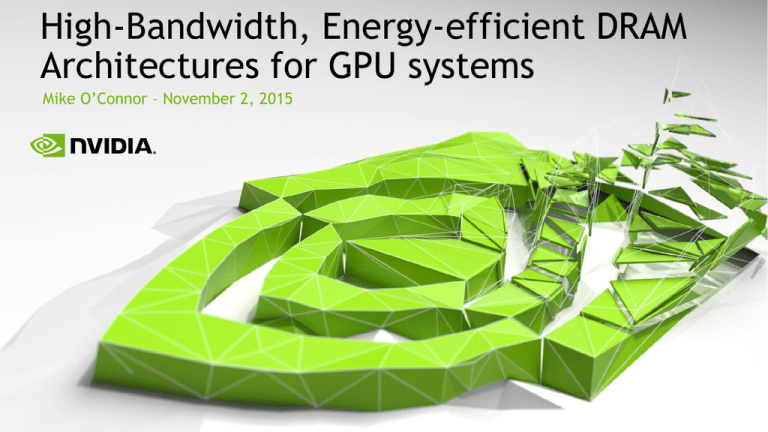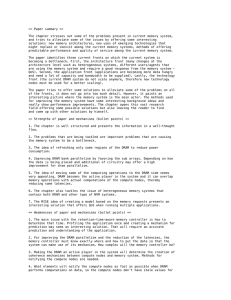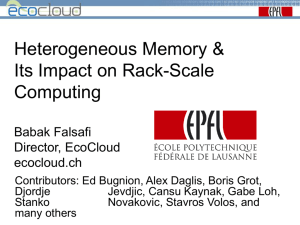High-Bandwidth, Energy-efficient DRAM Architectures for GPU systems
advertisement

High-Bandwidth, Energy-efficient DRAM Architectures for GPU systems Mike O’Connor – November 2, 2015 GPUs Demand High DRAM Bandwidth 2 GPUs Demand High DRAM Bandwidth 2008: NVIDIA Tesla GT200 512-bits @ 2.2 Gbps 3 GPUs Demand High DRAM Bandwidth 2010: NVIDIA Fermi GF100 384-bits @ 3.7 Gbps 4 GPUs Demand High DRAM Bandwidth 2013: NVIDIA Kepler GK110 384-bits @ 6 Gbps 5 GPUs Demand High DRAM Bandwidth 2013: NVIDIA Maxwell GM200 384-bits @ 7 Gbps 6 GPUs Demand High DRAM Bandwidth 2013: AMD Fury X “Fiji” 4096-bits @ 1 Gbps 7 GPUs Demand High DRAM Bandwidth Future GPU with 4-stack HBM2 4096-bits @ 2 Gbps 8 GPUs Demand High DRAM Bandwidth 4 TB/sec Exascale Node Target 9 GPUs Demand High DRAM Bandwidth CPUs, Not so Much Typical PC CPU 2 Channel DDR3-1600 51.2 GB/sec 10 GPUs Demand High DRAM Bandwidth CPUs, Not so Much Newer High-End CPU 2 Channel DDR4-3200 102.4 GB/sec 11 Why Do GPUs Demand so Much Bandwidth? Lots of compute 24 Streaming Multiprocessors each w/ 128 execution units Lots of threads 64 warps of 32 threads per SM 49,152 threads executing simultaneously on 3072 execution units NVIDIA Maxwell GM200 12 Why do GPUs Demand so Much Bandwidth? Different Memory Hierarchies 6 MB Register File 6 (Holds MB Register state File for many threads) 25.25K Register File (PRF) 128K L1 ~2 MB L1 and Scratchpad 2.3 MB L1/Scratchpad 512K L2 8 MB L3 3 MB L2 Intel Core i7-4790 NVIDIA Maxwell GM200 13 Why do GPUs Demand so Much Bandwidth? Radically Different Memory Hierarchies per Thread 3.28K Register File (PRF) 16K L1 128B Register File ~2 Register MB L1 and Scratchpad 6 MB File (Holds state48B forL1/Scratchpad many threads) 64K L2 64B L2 NVIDIA Maxwell GM200 49,152 Threads 1 MB L3 Intel Core i7-4790 8 Threads 14 Why do GPUs Demand so Much Bandwidth? Radically Different Memory Hierarchies per Thread 3.28K Register File (PRF) 16K L1 128B Register File ~2 Register MB L1 and Scratchpad 6 MB File (Holds state48B forL1/Scratchpad many threads) 64K L2 64B L2 NVIDIA Maxwell GM200 49,152 Threads 1 MB L3 Intel Core i7-4790 8 Threads 15 Whole Different Ballgame vs. typical CPU 25x More Bandwidth Less sensitive to latency LESS regular access patterns More sensitive to tRRD/tFAW 16 I thought GPUs had regular/streaming accesses? GPU warp = 32 Threads executed in SIMD manner http://www.shopbuy.org/static/category/original/rope/ LD r1, [r2+tid.x] 14174435-seamless-heamp-rope-texture-pattern.jpg Nice, Coalesced load of 32 x 4B = 128B 17 I thought GPUs had regular/streaming accesses? But a lot is happening in parallel… 18 I thought GPUs had regular/streaming accesses? But a lot is happening in 24 SM’s… parallel… 64 warps each… Highly interleaved execution! HA HA HA! I will bring Chaos to your puny DRAM system! 19 CPU Fewer threads, lower chance of bank conflicts Typical CPU : 8 Threads 2 ranks/channel 8 banks per rank http://www.shopbuy.org/static/category/original/rope/ 14174435-seamless-heamp-rope-texture-pattern.jpg 4 banks per thread 20 GPU Many different threads competing 6 channels 16 banks per channel NVIDIA Titan X: 1536 Warps 0.06 banks per warp 21 What does this mean for Energy? Low Accesses per Activate Average ~160 Bytes accessed per activate (5 x 32B) 22 What does this mean for Energy? Low Accesses per Activate Compositing Images High Accesses per Activate workloads are typically simpler functions like large data copies 23 What does this mean for Energy? Graph Analytics Low Accesses per Activate Many of the 1 Access/Activate workloads are are doing graph traversals of large graphs 24 What does this mean for Energy? Want to reduce row overfetch DRAM device typically has 1-2KB row - we only need 160B on average Wastes ~84-92% of the energy on activate/precharge of a DRAM bank Multiple devices in parallel (like a DIMM) make this even worse 25 What does this mean for Performance? Activate rate is a key High-bandwidth I/O is nice, but… Key aspect of performance is rate of activates - low tRRD and tFAW - high number of channels Typical 2-channel, 2-rank DDR4 w/ tRRDeff=5.25ns: 762 M ACT/sec HBM2 4-stack, 64-channel (w/ pseudochannels) w/ tRRDeff=4ns: 16 G ACT/sec 26 Small DRAM Atoms DRAM “atom” is smallest indivisible access Basically a function of bus-width and burst-length GPUs extensively use compression of graphics surfaces Efficiency of compression a function of minimum access size Efficient partial coverage 27 What to GPUs need from DRAM? High Bandwidth (w/ low access / activate) Energy-efficient (largely because of high bandwidth) Small minimum burst sizes (e.g. 16-32B) Not necessarily concerned with: Low-latency Extremely large capacities Lowest possible cost 28 One Approach: High-Speed Signaling Start with a commodity DRAM core Since GPUs don’t need huge capacities, drop multi-rank support Without multi-drop busses and sockets, push I/O data rates Beef-up the DRAM core to keep up (reduce tRRD/tFAW if possible) Basic approach behind GDDR DRAMs 29 GDDR5 GDDR5 signals at up to 8 Gbps GDDR5X soon going to 10-12 Gbps Lots of board challenges I/O energy efficiency not so great 30 Challenges with High-speed Signaling Limits on data rates with inexpensive board & package High-data rates place demands on the DRAM core - Cycle the DRAM core arrays faster And/Or - Sub-partition pieces of the DRAM array And/Or - Fetch more data from the array each time 31 Another Approach: In-package Integration 3D Stacking technologies enable many more I/Os What if instead of faster, we go wider… 32 What is High-Bandwidth Memory (HBM)? Memory standard designed for needs of future GPU and HPC systems: Exploit very large number of signals available with die-stacking technologies for very high memory bandwidth Reduce I/O energy costs Enable higher fraction of peak bandwidth to be exploited by sophisticated memory controllers Enable ECC/Resilience Features JEDEC standard JESD235, adopted Oct 2013. Initial work started in 2010 33 What is High-Bandwidth Memory (HBM)? Enables systems with extremely high bandwidth requirements like future highperformance GPUs 34 HBM Overview Channel 0 4 DRAM dies with 2 channels per die Channel 1 Optional Base “Logic” Die Each HBM stack provides 8 independent memory channels These are completely independent memory interfaces Independent clocks & timing Independent commands Independent memory arrays In short, nothing one channel does affects another channel 35 HBM Overview - Bandwidth Each channel provides a 128-bit data interface Data rate of 1 Gbps per signal (500 MHz DDR) HBM2 bumps this to 2 Gbps per signal (1 GHz DDR) 16-32 GB/sec of bandwidth per channel 8 Channels per stack 128-256 GB/sec of bandwidth per stack For comparison: Highest-end GDDR5-based today (NVIDIA GeForce GTX 980Ti) 384b wide GDDR5 (12 x32 devices) @ 7 Gbps = 336 GB/s AMD Fury X with 4 stacks of HBM Four stacks of HBM @ 1 Gbps = 512 GB/s Future possible GPU with 4 stacks of HBM2 Four stacks of HBM2 @ 2 Gbps = 1 TB/s 36 HBM Overview - Bandwidth Each channel provides a 128-bit data interface Data rate of 1 Gbps per signal (500 MHz DDR) HBM2 bumps this to 2 Gbps per signal (1 GHz DDR) 16-32 GB/sec of bandwidth per channel At lower overall DRAM 128-256 GB/sec of bandwidth per stack system power – For comparison: 6 pJ/bit vs. GTX 980Ti) Highest-end GDDR5-based today~(NVIDIA GeForce 8 Channels per stack ~18x32 pJ/bit for@GDDR5 384b wide GDDR5 (12 devices) 7 Gbps = 336 GB/s AMD Fury X with 4 stacks of HBM Four stacks of HBM @ 1 Gbps = 512 GB/s Future possible GPU with 4 stacks of HBM2 Four stacks of HBM2 @ 2 Gbps = 1 TB/s 37 HBM Overview - Capacity Per-channel capacities supported from 1-32 Gbit Stack capacity of 1 to 32GBytes Nearer-term, at lower-end of range HBM: 4 high stack of 2Gb dies = 1GBytes/stack HBM2: 4 high stack of 8Gb dies = 4GBytes/stack 8 or 16 banks per channel 16 banks when > 4Gbit per channel (> 4GBytes/stack) Not including optional additional ECC bits A stack providing ECC storage may have 12.5% more bits 38 HBM Channel Overview Each channel is similar to a standard DDR interface Data interface is bi-directional Still requires delay to “turn the bus around” between RD and WR Burst-length of 2 (32B per access) Requires traditional command sequences Activates required to open rows before read/write Precharges required before another activate Traditional dram timings still exist (tRC, tRRD, tRP, tFAW, etc.) – but are entirely per-channel 39 HBM Channel Summary Function # of µBumps Notes Data 128 DDR, bi-directional Column Command/Addr. 8 DDR Row Command/Addr. 6 DDR Data Bus Inversion 16 1 for every 8 Data bits, bi-directional Data Mask/Check Bits 16 1 for every 8 Data bits, bi-directional Strobes 16 Differential RD & WR strobes for every 32 Data bits Clock 2 Differential Clock Clock Enable 1 Enable low-power mode Total 193 40 New: Split Command Interfaces 2 semi-independent command interfaces per channel “Column Commands” – Read / Write “Row Commands” – ACT / PRE / etc. Key reasons to provide separate row command i/f: 100% column command bandwidth to saturate the data bus w/ BL=2 Simplifies memory controller Better performance (issue ACT earlier or not delay RD/WR) Still need to enforce usual ACTRD/WRPRE timings 41 New: Single-Bank Refresh Current DRAMs require refresh operations Refresh commands require all banks to be closed ~ 1 refresh command every few µsec Can consume 5-10% of potential bandwidth Increasing overheads with larger devices Sophisticated DRAM controllers work hard to overlap ACT/PRE in one bank with traffic to other banks Can manage the refresh similarly Added “Refresh Single Bank” command Like an ACT, but w/ internal per-bank row counter Can be issued to any banks in any order Memory controller responsible for ensuring all banks get enough refreshes each refresh period 42 New: RAS Support HBM standard supports ECC Optional: Not all stacks required to support it ECC and non-ECC stacks use same interface Key insight: Per-byte data mask signals and ECC not simultaneously useful Data Mask Signals can carry ECC data - makes them bi-directional on HBM stacks that support ECC 43 Other HBM Features HBM supports Temperature Compensated Self Refresh Temperature dependent refresh rates with several temperature ranges (e.g. cool/standby, normal, extended, emergency) Temperature sensor can be read by memory controller to adjust its refresh rates as well DBIac Data Bus Inversion coding Reduce number of simultaneously switching signals No more than 4 of 9 (DQ[0..7], DBI) signals switch DBI computation maintained across consecutive commands 44 HBM2 – The next step Evolution of HBM Doubles bandwidth of I/O channel Requires doubling burst-length and DRAM atom Break up channel into two pseudo-independent half-wide channels Pseudochannels add bank-level parallelism Prevent DRAM atom size from increasing Reduce DRAM row overfetch by cutting effective row in half 45 High Bandwidth DRAM Energy Trends 46 Conclusion GPUs place significant requirements on the DRAM Ideal GPU DRAM provides energy efficient high-bandwidth to small quantities of data Stacked memories like HBM2 are good, but need new innovations to get to Exascale-class nodes 47





